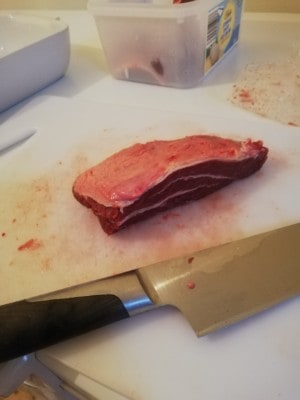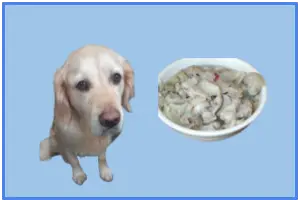
Fat is an integral part of dogs’ diet; they rely on it in order to stay healthy.
But, while our canine friends can eat more fats than we do, too much fat can also be bad for them.
And today, I want to focus on steak or beef fat.
As responsible dog owners, we want to provide our dogs with all the nutrients that they might need in their diet for healthy functioning.
So how do you strike the right balance of fats in your dog’s diet?
And are all meat-based fats created equal or are some better for your dog?
Today we’ll be covering all these questions, and more, in detail.
- Steak fat vs beef fat- is there a difference?
- Does beef fat have any nutrition?
- Why do dogs need fat in their diet?
- What happens if a dog eats too much fat?
- How much steak fat should I feed my dog?
- What is beef tallow and should dogs eat it?
- Raw vs cooked beef fat. Which is better?
- Steak vs pork vs lamb vs chicken fat
- Is there any difference between these fats?
- Conclusion: Should dogs eat beef fat?
Steak fat vs beef fat- is there a difference?
To keep things simple, there is not real difference between steak and beef- they are both cuts of meat from a cow.
Beef tends to be a larger piece of meat which is used to feed a group of people, whereas steak is a cut of meat which is used to feed one person.
And so beef fat and steak fat are the same thing.
Beef can be cut from any part of the cow, just as steak can.
And the best cuts of beef and steak come from muscles in the cow that haven’t been used much- such as the ribs.
Does beef fat have any nutrition?
The most important part of any diet is the nutrition one might get from it. So we’ll start with this question.
A 100g serving of steak fat contains 902 calories, is chock-full of concentrated fat, has a moderate amount of cholesterol, and little to no carbs and proteins.
To summarize, you can feed your dog beef fat, but only in moderation; since high steak fat diets are linked to a variety of health issues in dogs.
It also doesn’t contain other essential nutrients, like proteins and carbs, that your dog needs.
Why do dogs need fat in their diet?
As mentioned earlier, dogs need fat in their diet. Their metabolism relies on it for energy when they’re resting, and during light to moderate intensity workouts.
But dogs don’t just need fat for energy, it’s responsible for reducing inflammation in their body, is needed for a healthy skin and coat, it slows down the rate of their stomach emptying (so they feel fuller after meals), and is important for the absorption and digestion of fat-soluble vitamins (A, D, E, and K).
What happens if a dog eats too much fat?
Both too much, and too little, fat in your dog’s diet can cause issues.
While it’s true that dogs can tolerate more fat in their diet than we can, overloading your dog with fat will still him/her at a higher risk of pancreatitis and obesity, along with other complications.
Obesity in dogs comes with its own set of issues, including but not limited to: shorter life span, heart disease, cancer, diabetes, hypertension, and osteoarthritis.
How much steak fat should I feed my dog?
You can include beef fat in your dog’s daily diet, as long as you make sure that s/he’s getting all the other nutrients that a dog needs.
As a rule, your dog’s daily diet should contain 10-15% of fat; at times you can go as high as 25-30% but make sure not to do it on a daily basis.
Feeding your dog too much fat will lead to him/her feeling full without consuming essential nutrients. As mentioned above, too much fat can cause a variety of issues in dogs.
What is beef tallow and should dogs eat it?
Beef tallow is a very popular, and cheap, diet for dogs.
It’s considered unhealthy for humans, and you might be concerned if it’s safe for your dog.
The simple answer is that beef tallow is perfectly fine for your dog to eat, as long as you make sure that your dog is getting a balanced diet.
Raw vs cooked beef fat. Which is better?
The kind of fat you’re giving to your dog matters more than whether you’re giving it raw or cooked.
Make sure that the fats you’re feeding your dog contain Omega-3 and Omega-6 fatty acids.
As for cooked beef fat, it is fine as long as you make sure that it doesn’t contain onions, spices, artificial flavoring, or sauces.
If you’re introducing raw or cooked steak fat to your dog, it’s important to do it slowly or gradually so your dog’s digestive system can get used to it.
Introduce very small portions and slowly increase them.
Even after you’ve increased the portions, the fat should not constitute more than 10-15% of your dog’s daily diet.
Steak vs pork vs lamb vs chicken fat
The differences between these fats are nutritional.
We’ll cover the major nutritional differences one by one.
1. Beef fat contains high levels of saturated fat.
Out of the four mentioned, it also contains the highest number of calories.
While beef fat is generally considered bad for human consumption, it’s perfectly fine for dogs (in moderation).
It is also high in Omega-3 fatty acids, which are essential for your canine friend.
2. Compared to beef fat, pork fat is lower in saturated fat and calories, and slightly lower in cholesterol.
But, unlike beef fat, it contains a lot of protein, which is essential for dogs. Like beef fat, pork fat is also high in Omega-3 and Omega-6 fatty acids.
3. When it comes to calorie count, lamb fat is almost identical to pork fat.
The differences come in the form of roughly 33% lower protein than pork fat and higher vitamin B-12.
Lamb fat is also quite low on Omega-3 fatty acids.
4. Lastly, chicken fat.
Chicken fat contains the second highest number of calories in this list.
It is highly digestible and has high levels of Omega-6 fatty acids. It also has high levels of Vitamin D and E.
Is there any difference between these fats?
We’ve mentioned the notable differences between these fats above.
You should use these fats based on what kind of nutrients you’re looking to include in your dog’s diet.
Switch between these fats so your dog gets a healthy diet of both Omega-3 and Omega-6 fatty acids, as well as other nutrients.
We keep mentioning those two types of fatty acids in particular because your dogs cannot produce these on their own, so they have to be included in your dog’s diet.
Beyond these major differences, there are minor differences between these fats.
Do thorough research on your part before introducing one of them to your dog’s diet.
Which meat has the least fat?
In non-lean meats, chicken has by far the least amount of fat. However, beef, pork, and lamb meats with their fat content trimmed off can be just as lean as chicken.
Which animal fat do dogs tend to stomach more?
The answer to this question largely depends on your dog, and which fat you’ve gotten him/her used to.
Beef, chicken, lamb, and pork fat are all generally pretty easy for dogs to stomach and digest.
If you want to start your dog off on one of these, start small and go slow; gradually increase the fat serving and your dog will get used to it.
Conclusion: Should dogs eat beef fat?
We covered a lot of stuff about your dog’s nutritional needs today. All in all, the following points were discussed.
- Although beef fat only contains concentrated fat and a bit of cholesterol, it is needed as part of dogs’ diet (in moderation) to help their metabolism, reduce inflammation, and give them a healthy skin and coat. It also helps with their digestion of vitamins A, D, E, and K, while making them feel fuller after meals.
- Not feeding your dog too much fat is just as important as not feeding him/her too little of it. Too much fat in your dog’s diet can cause issues like feeling full without consuming important nutrients necessary for his/her wellbeing. Generally, making fat 10-15% of the overall daily diet should be good enough.
- While making sure your dog gets all the other important nutrients, you can sometimes increase the amount of fat to 25-30% as well, but do it only sporadically.
- Just like raw beef, cooked beef is also fine for your dog, as long as you don’t cook it with onions, artificial flavoring, sauces, and spices. And, unlike for humans, beef tallow is perfectly fine for dogs as long as the previous points are kept in mind.
- Although they both have high levels of Omega-3 and Omega-6 fatty acids, beef fat contains high levels of saturated fat and calories, whereas pork fat contains them at lower levels but has a lot of protein which necessary for your dog’s nutrition. Lamb fat is quite similar to pork fat, except with lower protein and higher vitamin B-12, while chicken fat has vitamin D and E along with the second highest level of calories.
- Which of these fats to include in your dog’s diet largely depends on the kind of nutrients you want to add to the diet. All of the fats mentioned above are perfectly safe for your dog. Gradually introduce any of them into his/her diet and your dog will get used to it.
With that, today’s topic comes to an end. We hope you found it informative and helpful. If there’s anything you would like us to cover in our next topic, please do let us know.





